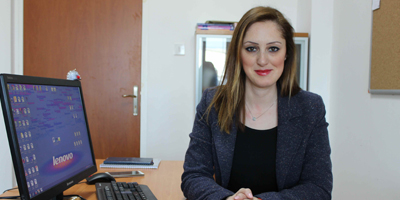EUL lecturer Ergin gave information about Aqua-lymphatic therapy in Lymphoedema Treatment

Assist. Prof. Dr. Gülbin Ergin, The Head of European University of Lefke (EUL) Physiotherapy and Rehabilitation Department, explained about “Aqua-Lymphatic Therapy-A New Approach in the Treatment of Lymphoedema”.
Explaining that many capillary blood vessels close to the surface of the skin leak constantly water and protein under the skin and that this fluid is the task of the lymphatic channels to collect under the skin, Ergin stated that protein and water accumulate between the tissues when the lymphatic channels are inadequate for any reason, leading to the formation of lymphedema.
Ergin: Lymphoedema affects the quality of life of the patient negatively
Ergin said that Lymphoedema gives heaviness-like feeling to the arm or the leg in the affected area, preparing the ground for infection, as it affects the quality of life of the patient with pain and decreased motivation. According to Ergin; although lymphedema can develop for different reasons, the etiology is not so important in the planning of the treatment, but the phase of the anatomic disorder during the planning of the effective treatment is more important.
Ergin said that lymphedema staged according to the characteristic clinical appearance and symptoms of the patients, which is usually graded as mild, moderate and severe according to their severity. Ergin stated that the most effective method in the treatment of lymphedema today is “Complex Decongestive Physiotherapy”. The aim of this method is to promote the patient’s education about lymphedema and the participation of the patient in the home program, to accelerate the lymphatic system of the affected area and to dissipate the accumulated protein, to prevent the occurrence or recurrence of the infection and to help the patient to cope with psychological problems. Emphasizing that the complex decongestive physiotherapy is divided into Phase 1-treatment phase and Phase 2-protective phase, and that each phase consists of four parts, the treatment phase is performed by physiotherapists trained on complex deconjugative physiotherapy in 4 or 8 weeks, as in Phase 2, the patient was being educated on how to continue this program.
Ergin: A new method of aqua-lymphatic therapy in the treatment of lymphedema
Ergin said that because lymphoedema is a chronic and progressive disease, patients should apply the protective phase steps self-drainage, the use of compression garments and exercises. Ergin said that the patients had difficulty in making the protective phase steps into a habit in their daily lives and that some of the patients had applied some of the protective phase program steps and some have applied none. Ergin said that new methods are needed to motivate patients to increase their participation in treatment. A new method of applying Aqua-Lymphatic Therapy for this purpose is an innovative approach that integrates the physical properties of the water with the anatomical and physiological principles of the lymphatic system.
Ergin said that patients should use silicone cream before each session to preserve the lymphedema and moisturizing cream to protect the pH level of the skin after the session. She pointed out that when the water temperature was 32 ° C, the hydrostatic pressure caused the lymphatic flow to accelerate, and that the pump affected is achieved on the lymphatic vessels by using water resistance and by creating pressures at different levels.
Ergin stated that group treatment was more advantageous than individual treatment in the aqua-lymphatic therapy. Ergin also stressed that the physiotherapist who has received the Complex Decongestive Physiotherapy certificate strengthened the group’s dynamism by being a patient supervisor in the pool. As a result of the studies carried out, Ergin stated that the aqua-lymphatic therapy programs given in the protection phase of complex decongestive physiotherapy, accompanied by physiotherapist, decrease the volume of the affected region and increase the quality of life. Ergin noted that the inclusion of patients into the group treatment program at certain intervals in the presence of a physiotherapist is quite beneficial both physically and psycho-social.
